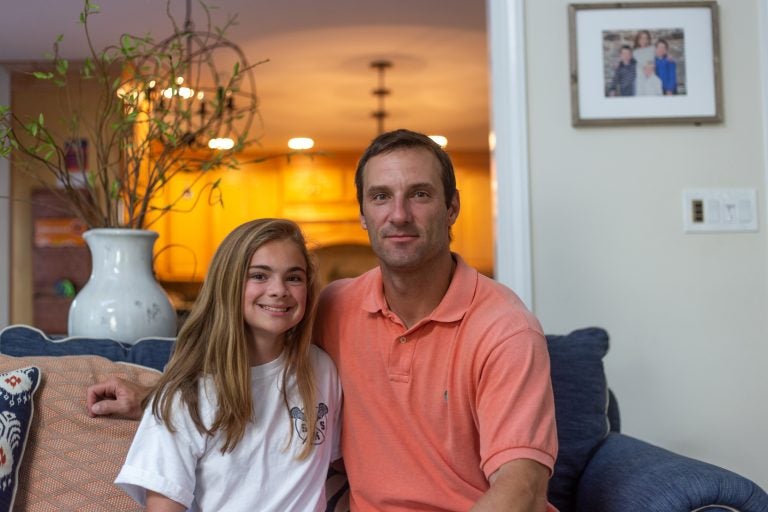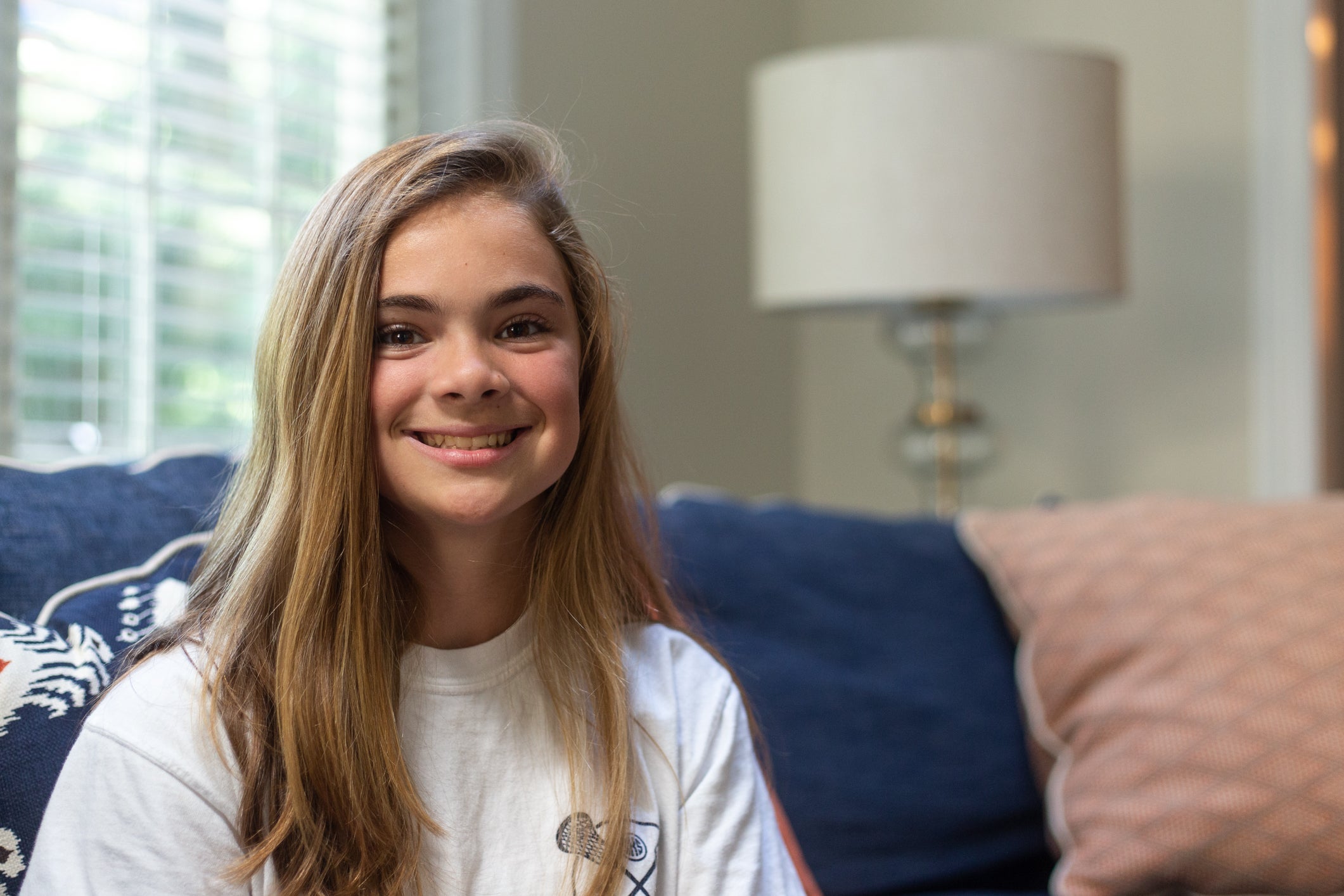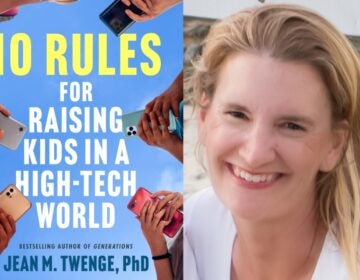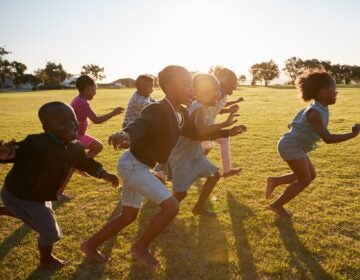Migraines in children? It’s more common than you think
By the time kids reach 10 years of age, about 10% of them are dealing with recurrent headaches. Some are tension headaches. Some are migraines.
Listen 4:49
Lexi DiMarino and her father, Keith DiMarino, sit for a portrait in their Wayne, Pennsylvania home. Following a migraine that Lexi endured for 100 days in a row, the father-daughter pair have become outspoken advocates for pediatric migraine awareness. (Angela Gervasi for WHYY)
How do we help children thrive and stay healthy in today’s world? Check out our Modern Kids series for more stories.
The typical 13-year-old hopes to avoid homework, a school presentation, maybe a list of chores.
What Lexi DiMarino dreads is the searing pain that sometimes radiates through her head — the inevitable consequence of her migraine headaches.
Migraines have intruded on Lexi’s life since she was 6 years old. Determined to conquer each bout of pain, she pushes herself. In the middle of migraines, she shows up for class, hops onto a treadmill at the gym, plays field hockey and lacrosse.
Her doctor, Donna Stephenson, applauds it — physical activity helps in the long run.
“Exercise releases all sorts of wonderful, happy neurochemicals in our brain,” said Stephenson, a pediatric neurologist at Children’s Hospital of Philadelphia.
Still, the episodes can be earth-shattering. When Lexi was 12, a sinus infection triggered a migraine that festered for 110 days — almost four months.
During that migraine, she was hospitalized twice and followed a strict diet. While she tried to keep up her schedule of classes and sports, many days were spent lying in the dark. She remained resilient, though.
“I would just wake up and be like, it’s OK, maybe tomorrow, and then maybe the next day,” said Lexi, who coached herself through the painful weeks.
Her father and mother — the latter suffers from migraine as well— tried to stay positive for their daughter. During Lexi’s months-long migraine, they celebrated small victories, like being able to read a book, or spending time in the sun without feeling overwhelmed by the pain.
“As a parent, you hope it ends right away,” said Keith DiMarino, Lexi’s father.
Finally, the pain began to subside. Lexi was able to be a kid again, hosting sleepovers, hopping on amusement park rides, eating chocolate (a common trigger for migraines).
According to Stephenson, a three-month migraine is extremely rare. But migraine in kids? Not so unusual.
More than a ‘myth’
“I think there is this propagated myth that children don’t have migraines,” Stephenson said.
The facts tell a different story: In the past fiscal year, CHOP has treated about 10,000 children for migraine and tension headaches.
By the time kids reach 10 years of age, about 10% of them are dealing with recurrent headaches. Some are tension headaches, and others, Stephenson said, are migraines.
“So headache and migraine (are) a very common human experience,” she said.
While tension headaches can be moderately painful, migraines are often debilitating. Unlike the average headache, migraine in kids is “sufficiently severe to stop their participation in their usual activities,” Stephenson said.
Migraines appear differently in children: They’re typically shorter-lived. While adults typically feel migraines on one side of the head, kids tend to feel pain on both sides. And while kids have more difficulty describing the pain, patterns in their behavior can reveal some clues for parents, Stephenson said.
“They will usually go to the couch or go lie down somewhere quiet. They won’t want to watch television. They sometimes look pale, look ill, they might throw up with their headache,” Stephenson said.
And as kids inch closer to adulthood, the likelihood of migraine increases. About 23% of girls and 8% of boys have experienced migraines by the time they turn 17 years old, according to the Migraine Research Foundation.
Sleep, screens and other triggers
When Susan Finn treats children for migraine, she runs through a checklist: lack of sleep, skipped meals and dehydration are prevalent factors. Finn also reminds kids to cut down on screen time.
“We usually see a lot of frowny faces,” said Finn, a pediatric nurse practitioner at St. Christopher’s Hospital for Children in Philadelphia.
Though children can be hesitant to cut down on technology, it’s crucial to their well-being, Finn said. Falling asleep in front of a television screen, for example, can cause a child to sleep poorly or insufficiently — also a migraine trigger.
With more classrooms incorporating technology like laptops and SmartBoards, kids could be getting more daily screen time than a parent might realize, she added.
“So we always recommend no electronics in the bedroom, whatsoever. No phones, no tablets,” Finn said.
And while a parent’s first instinct might involve some acetaminophen or ibuprofen, Finn warned against using them more than three times per week. Analgesic overuse, she said, can cause rebound headaches, inflaming a child’s pain even further.
For kids experiencing migraine headaches at least two to three times a week, Finn said, she considers prophylactic, or preventative, medication to block the headache before it begins.
Challenging migraine
After years of watching his daughter battle through the headaches, Keith DiMarino noticed another potential problem for kids dealing with migraine: They don’t want to stand out.
“You want to blend in and be normal like the other kids, but when you’re in pain, you know, you often don’t speak up,” he said.

As Lexi continued to push herself, a friend asked him if he’d be interested in participating in the Rim-to-Rim-to-Rim — a two-day hike that plunges from one side of the Grand Canyon to another.
The hike is notoriously strenuous, and DiMarino declined the invitation. A few days later, he was watching his own daughter run on a treadmill during a migraine.
“And I’m thinking, ‘Wow, that’s a pretty difficult thing to do physically,’” he said. “And here I am, in perfect health, complaining about a physical challenge that I could pick to do or not to do.”
DiMarino changed his mind. He began training to embark on the 48-mile challenge, donating the money to CHOP.
At first, Lexi was skeptical.
“I told him not to because I thought he was going to get hurt,” she said with a smile. “And he was like, ‘No, I think I’m going to do it.’ I’m like, ‘No, thank you. Please don’t.’
After months of training and a trip out to Arizona, DiMarino completed the challenge. His inspiration? His daughter.
The hike, and the campaign he created raised thousands for CHOP. But, he said, raising awareness meant more than raising the money.
Staying ‘positive’ through the pain
Lexi receives support from her friends and peers. Still, it can be hard to explain pain that isn’t visible.
“If someone broke an arm, they would see the cast, and they would be like, ‘Oh, you broke your arm. That’s that.’ But it’s harder because they can’t necessarily see what I’m going through,” Lexi said.
“And it just looks like I’m normal when I’m really not,” she added.
To help children cope with the severity of migraine, CHOP offers behavioral cognitive therapy. Several times each year, the hospital hosts a migraine camp with yoga, education, and a chance for kids to bond.
“I think kids are probably tougher than most adults that I know,” said Stephenson, Lexi’s doctor. “If you can give them the positive mental attitude and the tools to get better, they are sometimes better able to utilize those than adults.”
WHYY is your source for fact-based, in-depth journalism and information. As a nonprofit organization, we rely on financial support from readers like you. Please give today.






